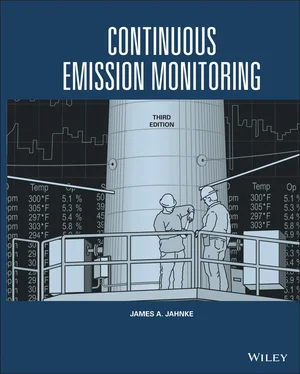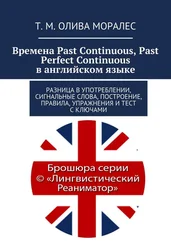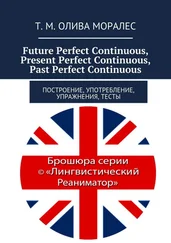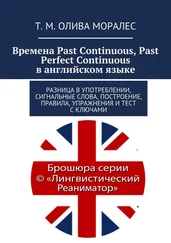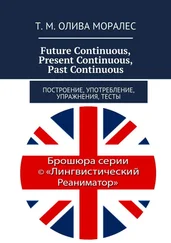James A. Jahnke - Continuous Emission Monitoring
Здесь есть возможность читать онлайн «James A. Jahnke - Continuous Emission Monitoring» — ознакомительный отрывок электронной книги совершенно бесплатно, а после прочтения отрывка купить полную версию. В некоторых случаях можно слушать аудио, скачать через торрент в формате fb2 и присутствует краткое содержание. Жанр: unrecognised, на английском языке. Описание произведения, (предисловие) а так же отзывы посетителей доступны на портале библиотеки ЛибКат.
- Название:Continuous Emission Monitoring
- Автор:
- Жанр:
- Год:неизвестен
- ISBN:нет данных
- Рейтинг книги:4 / 5. Голосов: 1
-
Избранное:Добавить в избранное
- Отзывы:
-
Ваша оценка:
- 80
- 1
- 2
- 3
- 4
- 5
Continuous Emission Monitoring: краткое содержание, описание и аннотация
Предлагаем к чтению аннотацию, описание, краткое содержание или предисловие (зависит от того, что написал сам автор книги «Continuous Emission Monitoring»). Если вы не нашли необходимую информацию о книге — напишите в комментариях, мы постараемся отыскать её.
The new edition of the only single-volume reference on both the regulatory and technical aspects of U.S. and international continuous emission monitoring (CEM) systems Continuous Emission Monitoring
Continuous Emission Monitoring:
Continuous Emission Monitoring, Third Edition
Continuous Emission Monitoring — читать онлайн ознакомительный отрывок
Ниже представлен текст книги, разбитый по страницам. Система сохранения места последней прочитанной страницы, позволяет с удобством читать онлайн бесплатно книгу «Continuous Emission Monitoring», без необходимости каждый раз заново искать на чём Вы остановились. Поставьте закладку, и сможете в любой момент перейти на страницу, на которой закончили чтение.
Интервал:
Закладка:
19 International Energy Agency (IEA) (1997). International Workshop on Continuous Emissions Monitoring. London: IEA Coal Research.
20 International Energy Agency (IEA) (1998). CEM98 – International Conference on Emissions Monitoring. EPA 450/2‐84‐004. London: IEA Coal Research.
21 Jahnke, J.A. (1984). Transmissometer Systems – Operation and Maintenance, an Advanced Course. EPA 450/2‐84‐004. Environmental Protection Agency‐Air Pollution Training Institute. Research Triangle Park
22 Jahnke, J.A. (1991). APTI Course 474 – Continuous Emissions Monitoring Systems. EPA 450/2‐91006A. Environmental Protection Agency‐Air Pollution Training Institute. Research Triangle Park.
23 Jahnke, J.A. (1993). Continuous Emission Monitoring, 1ee. New York: Van Nostrand Reinhold.
24 Jahnke, J.A. (1994). An Operator's Guide to Eliminating Bias in CEM Systems. EPA 430‐R‐94‐016. Environmental Protection Agency‐Acid Rain Division.
25 Jahnke, J.A. (2000). Continuous Emission Monitoring, 2ee. New York: Wiley.
26 Jahnke, J.A. and Aldina, G.J. (1979). Continuous Air Pollution Source Monitoring Systems Handbook. EPA 625/6‐79‐005. Cincinnati, OH: Environmental Protection Agency‐Center for Environmental Research Information.
27 Jahnke, J.A., Peeler, J.W., Juneau, P.J., and Kinner, L.L. (1997). Handbook – Continuous Emission Monitoring Systems for Non‐criteria Pollutants. EPA/625/R‐97/001.
28 Jiang, Y., Yong, L., and Hongjie, L. (ed.) (2000). Stationary Source Emissions and Continuous Automatic Monitoring, Chinesee. China Standard Press.
29 Lillis, J.E. and Schueneman, J.J. (1975). Continuous emission monitoring: objectives and requirements. Journal of the Air Pollution Control Association 25 (8): 804–809.
30 Lipták, B.G. and Venczel, K. (2016a). Instrument and Automation Engineer’s Handbook – Fifth Edition Volume I Measurement and Safety. Boca Raton: CRC Press.
31 Lipták, B.G. and Venczel, K. (2016b). Instrument and Automation Engineer’s Handbook – Fifth Edition Volume II Analysis and Analyzers. Boca Raton: CRC Press.
32 New Jersey Department of Environmental Protection (2010). Guidelines for Continuous Emissions Monitoring System (CEMS), Continuous Opacity Monitoring Systems (), Periodic Monitoring Procedures (PMPS), and Annual Combustion Adjustments (ACAs). Technical Manual #1005. New Jersey Department of Environmental Protection – Air Quality Permitting Program Bureau of Technical Services. www.state.nj.us/dep/aqpp/techman.html(accessed 3 June 2021).
33 Pennsylvania Department of Environmental Protection (PADEP) (2006). Continuous Source Monitoring Manual – Revision 8. 274‐030‐001. Pennsylvania Department of Environmental Protection. www.dep.pa.gov(accessed 3 June 2021)
34 Rausch, A., Werhahn, O., Witzel, O., Ebert, V., Vuelban, J., Gersl, J., Kvernmo, G., Korsman, J., Coleman, M., Gardiner, T., and Robinson, R. (2015) Metrology to Underpin future Regulation of Industrial Emissions. 17th International congress of Metrology, 07008. 07008. www.cfmetrologie.edpsciences.org. (accessed 24 January 2022)
35 Schakenbach, J., Vollaro, R., and Forte, R. (2006). Fundamentals of successful monitoring, reporting and verification under a cap‐and‐trade program. Journal of the Air & Waste Management Association 56: 1576–1583.
36 Skoog, D.A., West, D.M. Holler, F.J., and Crouch, S.R. (2017). Principles of Instrumental Analysis, 7ee. Boston, MA: Cengage Learning.
37 U.S. EPA (2020a). Code of Federal Regulations – Standards of Performance for New Stationary Sources. 40 CFR 60. Washington, DC: Office of the Federal Register.
38 U.S. EPA (2020b). Code of Federal Regulations – Performance Specifications, 40 CFR 60 Appendix B. Washington, DC: Office of the Federal Register.
39 U.S. EPA (2020c). Code of Federal Regulations – Quality Assurance Procedures. Protection of the Environment, 40 CFR 60 Appendix F. Washington, DC: Office of the Federal Register.
40 U.S. EPA (2020d). Code of Federal Regulations – National Emission Standards for Hazardous Air Pollutants for Source Categories, 40 CFR 63. Washington, DC: Office of the Federal Register
41 U.S. EPA (2020e). Code of Federal Regulations – Permits Regulation, 40 CFR 72. Washington, DC: Office of the Federal Register
42 U.S. EPA (2020f). Code of Federal Regulations – Sulfur Dioxide Allowance System. 40 CFR 73. Washington, DC: Office of the Federal Register.
43 U.S. EPA (2020g). Code of Federal Regulations – Continuous Emission Monitoring. 40 CFR 75. Washington, DC: Office of the Federal Register.
44 U.S. EPA. (2020h). Code of Federal Regulations – Specifications and Test Procedures, 40 CFR 75 Appendix A. Washington, DC: Office of the Federal Register.
45 U.S. EPA (2020i). Code of Federal Regulations – Quality Assurance and Quality Control Procedures, 40 CFR 75 Appendix B. Washington, DC: Office of the Federal Register.
46 Vermont Air Quality and Climate Division (2002) Continuous Emission Monitoring Regulations – Revision 5. Vermont Department of Environmental Conservation. www.dec.vermont.gov(accessed 3 June 2021).
47 Villa, T.F., Gonzalez, F., Mljievic, B. et al. (2016). An overview of small unmanned aerial vehicles for air quality measurements: present applications and future perspectives. Sensors 16 (1072): 1–29.
48 Wenlong, W., Xiaofeng, T., Song, C. et al. (ed.) (2011). Thermal Power Plant Continuous Flue Gas Emission Monitoring System Technology and Use. Beijing, China: Electric Power Press.
49 White, J.R. (1995). Survey your options: continuous emissions monitoring. Environmental Engineering World July‐August: 6–10.
50 Wiegleb, G., Franconia, O., Reinmann, J. et al. (2016). Gasmesstechnik in Theorie und Praxis. Springer Vieweg.
51 Willard, H.H., Merritt, L.L., Dean, J.A., and Settle, F.A. (2004). Instrumental Methods of Analysis, 7ee. New York: CBS Publishers.
52 Zhang, C. (2007). Fundamentals of Environmental Sampling and Analysis. Hoboken: Wiley.
CHAPTER 2 CEM REGULATIONS
Environmental control agencies have been the driving force for the installation of continuous emission monitoring systems. The emergence of CEM regulation in the 1970s brought a new perspective to emissions monitoring by requiring a wide range of sources to install systems and by requiring the installed systems to meet specified levels of performance. Although instrumentation had been applied in the 1960s to monitor product loss in the process industries, it was not until environmental control agencies began implementing pollutant monitoring rules that the CEM industry began to develop. This development began almost simultaneously in the United States and the Federal Republic of Germany (FRG). Monitoring requirements have since extended throughout the European Union (EU), to Canada, Latin America, the Middle East, and Asia.
National environmental regulatory programs have been initiated to protect the health and welfare of their citizens. Ultimately, regulatory agencies establish limits for pollutant emissions from stationary, mobile, and area sources. This book addresses emissions from stationary sources, i.e., emissions from “smoke stacks.” By measuring the amount of pollutants emitted from stationary sources, assessments can be made as to their contribution to environmental problems. The data that they generate can also serve as a basis for future emission control regulations. Once in place, continuous emission monitoring systems provide a means of keeping score. Although measurements can be made manually and periodically as they were before the 1970s, continuous emission monitoring provides an ongoing record of how well emissions are being controlled and a means of determining at any time, the compliance status of an emissions source with its emission agency‐specified emission limits.
Читать дальшеИнтервал:
Закладка:
Похожие книги на «Continuous Emission Monitoring»
Представляем Вашему вниманию похожие книги на «Continuous Emission Monitoring» списком для выбора. Мы отобрали схожую по названию и смыслу литературу в надежде предоставить читателям больше вариантов отыскать новые, интересные, ещё непрочитанные произведения.
Обсуждение, отзывы о книге «Continuous Emission Monitoring» и просто собственные мнения читателей. Оставьте ваши комментарии, напишите, что Вы думаете о произведении, его смысле или главных героях. Укажите что конкретно понравилось, а что нет, и почему Вы так считаете.
